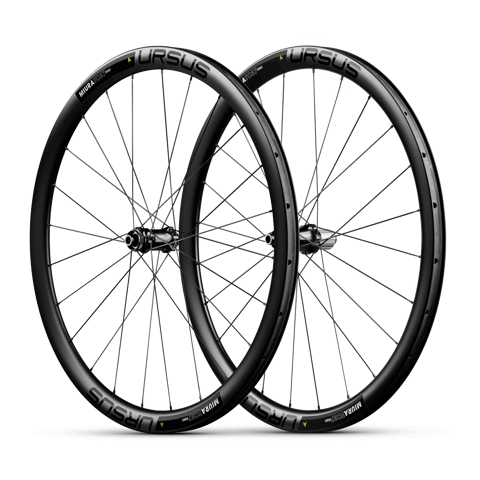Race
RACING BIKE WHEELS: TAKE ON COMPETITIONS AT YOUR BEST!
Ursus racing bike wheels are dedicated to the cyclist who wants to stand out from the crowd. Have fun with the unparalleled smoothness of our hubs, allowing you to achieve the best performance on road. You can choose the ultra-fast rims for tubulars or opt for the tubeless / clincher versions, ideal to improve your physical condition in training. Get on the road with us!
WHAT WILL YOU FIND IN THIS PAGE?
- ORIGIN AND HISTORY OF ROAD CYCLING
- THE GOLDEN YEARS OF CYCLING
- THE MOST BEAUTIFUL INTERNATIONAL CYCLING RACES
- NUTRITION IN ROAD CYCLING
- RACING BIKE COMPONENTS
- THE COMPONENTS OF A RACING BIKE WHEEL
- RACING BIKE WHEELS, FOR TRAINING AND FOR RACING
- TUBULARS OR CLINCHERS FOR RACING BIKE WHEELS?
- RACING BIKE WHEELS, NEW AND USED
- RACING BIKE WHEELS: CARBON OR ALUMINIUM?
- RACING BIKE BRAKES: DISC OR RIM?
- RACING BIKE HANDLEBAR
- RACING BIKE HANDLEBAR STEM
- RACING BIKE HUBS
- ACCESSORIES FOR RACING BIKES
- MAINTENANCE FOR YOUR RACING BIKE WHEELS
- HOW TO CLEAN YOUR RACING BIKE
- TOP RANGE RACING BIKE WHEELS: HERE ARE THE MIURA TC SERIES
- MIURA TS37 AND TS47 DISC: THE TUBULAR TIRES CHOSEN BY THE TOTAL DIRECT ENERGIE TEAM
- WHEELS FOR THE NORTHERN CLASSICS? THE TOTAL DIRECT ENERGIE TEAM TEST
- THE INTEGRATED RACING BIKE HANDLEBAR BY URSUS: MAGNUS H.01
ORIGIN AND HISTORY OF ROAD CYCLING
Throughout history, many bicycle-related sports activities have taken place. Road cycling is undoubtedly the most famous, most followed, and most practiced. The term "road" differentiates this discipline from those that take place on the track or on dirt, grass, and gravel, or on any type of circuit that is specially made for cycling. Road cycling differs not only from all other cycling sports, but from almost all sports in general, as the races take place on pre-existing roads.
What is the origin and history of cycling? The first cycling races date back to the second half of the 19th century, the first of which was reported to have taken place in Paris in 1868: a one-kilometre race that ran through the Parc de Saint-Cloud. People grew a passion for this sport, and sports clubs and competitions emerged, setting free this new impulse for competition. The first Italian race was the Florence-Pistoia, in 1870, a 35-kilometre race won by an American. In 1883, the first world championships were held in Leicester. In 1885, the Italian Velocipede Association was founded and seven years later, the International Cyclist Association was born, with the task of regulating the various national cycling federations.
THE GOLDEN YEARS OF CYCLING
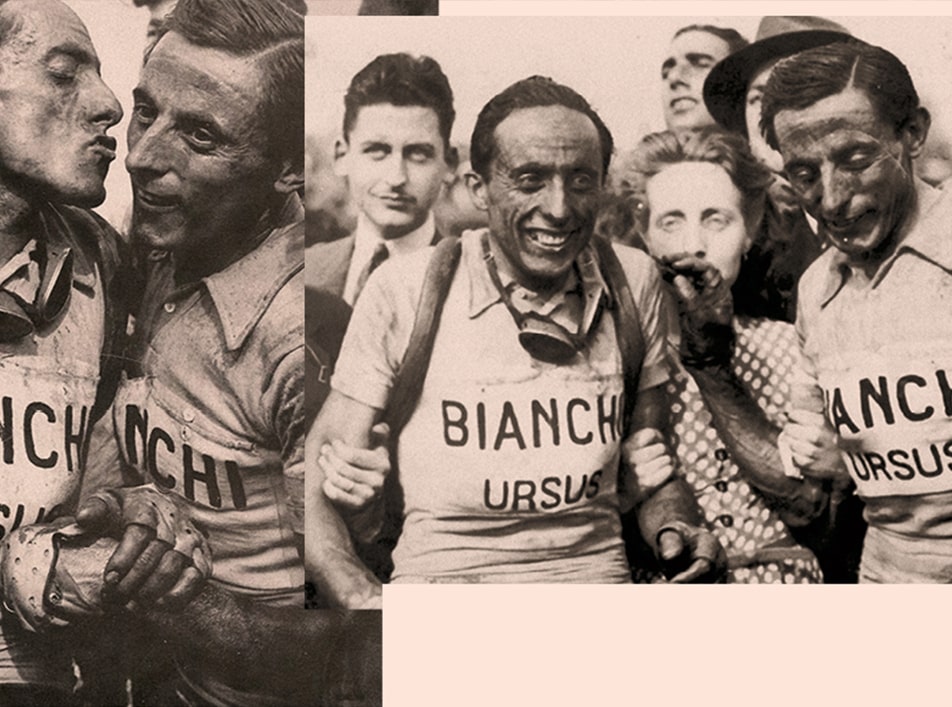
At the turn of the 20th century, cycling was starting to become a known sport and was practiced internationally. This period originated competitions which are still held today, contributing to making road cycling a legendary discipline. Of course, the first races have nothing to do with what we are used to see today: very long routes, even 500 kilometres, with races lasting more than 24 hours, on unpaved roads and with very heavy bicycles. This is another reason why cycling, especially how it was practiced in the past, is considered a heroic sport.
The popularity of road bikes exploded between the 1930s and 1950s, as the Second World War was taking place. This happened thanks to great cyclists, among which Fausto Coppi and Gino Bartali stand out above all, making cycling become just as important, and perhaps for a period even more, as the passion that people have for football.
From here on out, cycling started gradually growing, in every sense. The following was getting bigger, racers became true professional athletes, and the most successful ones had the chance to earn a lot of money. Over the years, racers also began to specialize, so a new generation of cyclists was born: some were strong only uphill, the climbers, some did best in sprints, the sprinters, and some were most experienced in time trial races. Fewer and fewer cyclists know how to succeed on all terrains and in any type of race.
The most important cyclists who have marked the history of this sport, in addition to the above-mentioned Coppi and Bartali, are Jacques Anquetil, Charly Gaul, Eddy Merckx, Felice Gimondi, Francesco Moser, Bernard Hinault, Laurent Fignon, Greg LeMond, Gianni Bugno, Miguel Indurain and Marco Pantani, up until today's champions, including Alberto Contador, Vincenzo Nibali, Chris Froom and Peter Sagan.
THE MOST BEAUTIFUL INTERNATIONAL CYCLING RACES
There are dozens of international cycling competitions, from those in stages to those which last a single day. However, the most famous races, the most loved by both cyclists and enthusiasts, are some of the most ancient and historical, whose charm and importance not only are undamaged by time, but have increased over the years.
As for stage races, the Tour de France, originating in 1903 and the Giro d’Italia, dated 1909, are the two most important races. It is every cyclist's dream to wear the yellow jersey and the pink jersey at least once, as these symbols are worn by the leaders of these two historic competitions. Separate due to longevity and importance is the Vuelta a España, whose first edition took place in 1935. These three great European road cycling stage races are part of the “Grand Tours”.
Among one-day races, the most important ones are called the “Monuments”, in other words, the great classics. The Liège-Bastogne-Liège started in 1892, the Paris-Roubaix in 1896, the Tour of Lombardy in 1905, the Milan-Sanremo in 1907 and the Tour of Flanders in 1913.
Other highly sought-after classic races are the Milano-Torino, the Strade Bianche, La Flèche Wallonne, the Paris-Tours and the Clásica de San Sebastián.
NUTRITION IN ROAD CYCLING
Cycling is considered to be one of the toughest sports in the world. A discipline characterized by its effort duration, requiring athletes to run on tracks that are often very demanding, and in all weather conditions. To withstand these efforts, the body needs to be substantially fed before the performance in order to store energy, as well as constantly during the race so as not to lose strength, and afterwards for recovery. Carbohydrates are very important, providing necessary amount of energy and proteins to the body, which help to rebuild muscle after a very demanding challenge. During the race, however, the best foods to consume are those which give energy, but that are quickly digestible. Modern cycling is well acquainted with gels and bars, which supply easily-to-digest carbs and proteins. Obviously, hydration is essential, which must include water and mineral salts.
TEST: WHAT KIND OF CYCLIST ARE YOU?
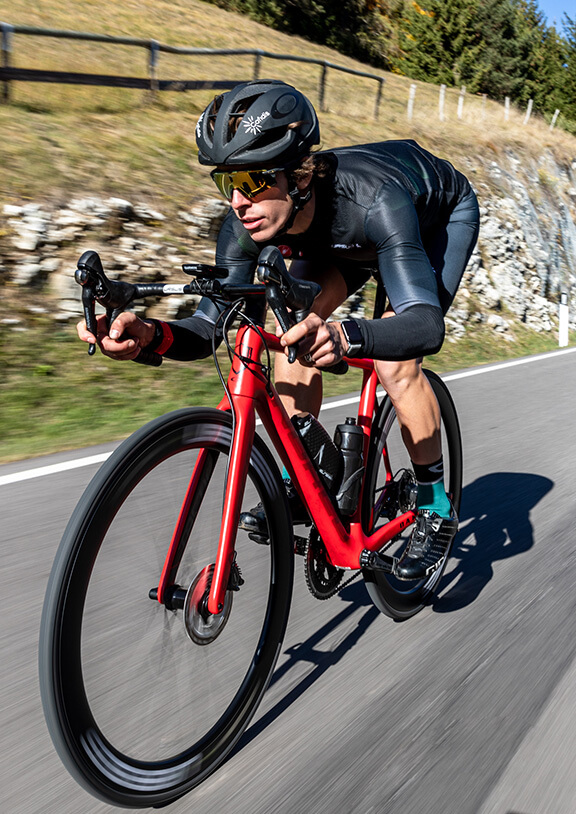
RACING BIKE COMPONENTS
A racing bike is a set of many technical components which, when mixed efficiently, allow the vehicle to work perfectly. Let’s examine the most important components, starting from the wheels.
THE COMPONENTS OF A RACING BIKE WHEEL
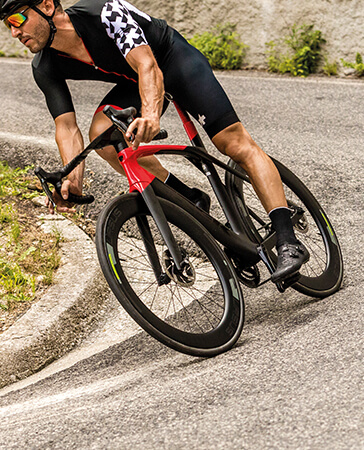
The wheels of a racing bike are an elements that we take for granted too often, while they are actually quite complex and one’s performance can depend on them. The wheels of a racing bike are made up of 4 components:
- hubs
- spokes
- rims
- tires
The hubs transform the energy generated through the pedals into centrifugal force, which is distributed on the spokes.
The spokes have three functions:
- they stabilize the rims, keeping them in position
- they sustain the weight of the cyclist and of the bike
- they absorb the irregularities of the road
The rims are connected to the hub through the spokes and hold the tires.
The tires are the part of the wheel that is in direct contact with the asphalt, with the task of giving grip to the racing bike.
RACING BIKE WHEELS, FOR TRAINING AND FOR RACING
As always, details make the difference. The use of different wheels for training and racing is clearly an aspect that characterizes professionals or high-level amateurs. Why do cyclists use different wheels? Mostly because of the long distances they travel and because at the start of each single race, the wheels are fine-tuned and modified in some of their components (for example the tubulars), or even replaced with new wheels – which certainly happens in case of damage.
A myth that must be dispelled is that racers use aluminium wheels in training, which are more resistant and therefore can guarantee more kilometres. To be at top form during the race, one must train to their full potential: that is why, even in training, the highest quality of the vehicle and its components are of the utmost importance.
One of the differences between training and competition is the use of clinchers or tubulars. The latter are chosen for competitions for their greater resistance and smoothness, but clinchers are preferred during training, since having the inner tube means that it can be replaced in case of puncture. Even pros, who often train alone or in small groups, do not always have a mechanic ready to support them.
TUBULARS OR CLINCHERS FOR RACING BIKE WHEELS?
Tubulars, as mentioned above, are the solution preferred by professionals and high-level amateur competitors.
Tubular tires offer three advantages over clinchers:
- more resistance
- more smoothness
- lighter weight
Tubulars, as they are glued to the rim and contain an inner tube, are very resistant, making it hard to suffer punctures due to pinching, which instead can happen with clinchers. Of course, tubulars are more difficult to change, but as all fans know, during races pros replace the entire wheel in case of a puncture.
Clinchers, compared to tubeless, offer the following advantages:
- they are less expensive
- they are easier to replace
- they can be used at a lower inflation level
These characteristics immediately show why clinchers are more suitable for amateurs. As for inflation, the inner tube can be inflated to a lower pressure than tubulars, without the risk of puncturing.
RACING BIKE WHEELS, NEW AND USED
Buying a used component for your racing bike is always a risk. It is even more so when it comes to wheels, as they are a very important, delicate, and equally sought-after element; given the significant cost, we try to save. But the chance of a bad purchase is very high.
What are the risks when buying used wheels?
- Lower performance
- Physical safety risks
Ads for second-hand racing bike wheels, with very few kilometres and great prices, are very appealing. But don’t get carried away by the excitement of a good deal. To proceed with the purchase, you must verify the quality and the distance travelled. Otherwise, after discovering the true condition of the wheels, you will have to buy another pair, and you will choose new ones in order to avoid deception. This double purchase is absolutely avoidable.
Furthermore, if you ride with low quality used wheels that are already too worn, the obvious consequence will be a significant drop in performance. In addition, the risk of accidents should not be underestimated: a worn-out wheel, as for any vehicle, can give less grip and therefore greater chances of losing control.
We generally suggest purchasing new products, unless you have the opportunity to buy second-hand components that are in good condition from people you trust.
Learn more about the differences between new and used racing bike wheels.
RACING BIKE WHEELS: CARBON OR ALUMINIUM?
The differences between carbon wheels and aluminium wheels can determine differences in performance. Carbon racing bike wheels are now used by all professional cyclists, while many amateurs prefer aluminium ones.
Carbon wheels offer the following advantages:
- Lighter weight
- Increased resistance
Lightness is the first important feature of carbon wheels for road bikes. The carbon fibre with which they are made means that inertia during rolling is significantly lower than with aluminium. This means greater smoothness, more speed with less effort, and therefore better performance.
In addition, unlike what many may think, modern production techniques allow the construction of very resistant, yet very light carbon wheels. Aluminium wheels can withstand serious impacts better, even if in reality, when a serious impact occurs, the damage usually warrants replacing the wheel altogether.
Aluminium wheels, however, have a great advantage: the price. They are certainly less expensive than carbon ones and therefore chosen by non-competitive cyclists, who are not interested in performance level.
Discover all the differences between racing bike wheels in aluminium and carbon.
RACING BIKE BRAKES: DISC OR RIM?
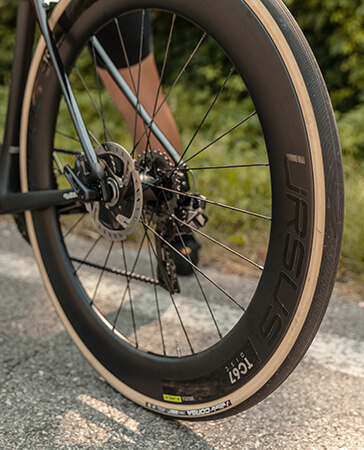
It is one of the most frequent discussions among cycling enthusiasts in recent years. Disc brakes are now very popular even among pros, but there are still many diehard supporters of classic brakes.
Disc brakes provide better braking than pad brakes in all conditions. On clean asphalt, their braking is very powerful, and therefore should also be controlled.
Disc brakes offer more guarantees because:
- Compared to rim brakes, even if they are used a lot, they do not risk efficiency loss by overheating
- In case of rain, water does not decrease their efficiency
Rim brakes, on the other hand, offer these advantages:
- They are less expensive
- They need less maintenance
Furthermore, rim brakes allow for easier wheel replacement, even though nowadays cyclist mechanics are becoming increasingly more familiar with disc brakes and therefore replacing the wheel is rather quick in this case too.
Discover the differences between rim and disc brakes for racing bikes.
RACING BIKE HANDLEBAR
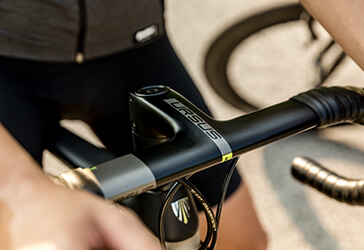
The handlebar is undoubtedly one of the components that most distinguishes racing bikes compared to all other bicycles. It is an element of fundamental importance because, along with the saddle and pedals, it is one of the three points of contact between the cyclist and the bicycle. The handlebar houses the elements that activate the brakes and gearbox and therefore must have a shape and size that make the cyclist feel completely at ease, offering comfort in the movements and safety in the grip. The main feature of the handlebar is the width, which must correspond to the width of the shoulders of the rider.
Racing bike handlebars are not always the same and vary particularly for bikes used in time trials. The key component to ensure that the handlebars and the bike frame are in perfect harmony is the stem.
RACING BIKE HANDLEBAR STEM
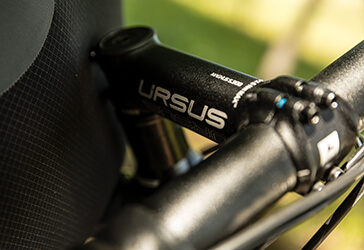
The handlebar stem of the racing bike is one of the most important elements for determining the correct position of the cyclist on the bike and therefore also improve comfort, pedalling fluidity, and performance.
The stems of a racing bike usually have a 6° angle and a length varying between 80 and 130 mm. The exact size allows to perfectly adapt a bike that, compared to the cyclist, has a frame that is too short or too long. To understand if the length of the stem of the bike right for you, get on the bike and hold the handlebar at the bottom: if the horizontal part of the handlebar prevents you from seeing the hub of the front wheel, the position is perfect. If not, a shorter or longer stem must be fitted.
RACING BIKE HUBS
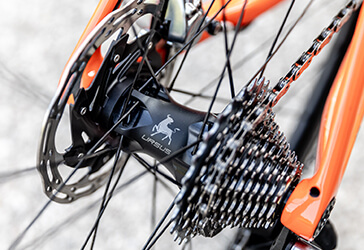
The hubs are one of the most important components of a racing bike.
Their importance is due to the fact that they represent the fulcrum of the movement of the wheel, with the task of transforming the force generated through the pedals into centrifugal force, which is distributed onto the spokes of the wheel. This is the process by which the pedalling force makes the bike move. The quality of the hubs and of the whole wheel are fundamental for effective and high-performance pedalling.
The hubs also have the task of ensuring the smoothness of the bicycle, reducing friction between components as much as possible. All hubs are not made equal: the one mounted on the front wheel is different the rear wheel, and hubs for disc brakes are different from those for classic brakes.
ACCESSORIES FOR RACING BIKES
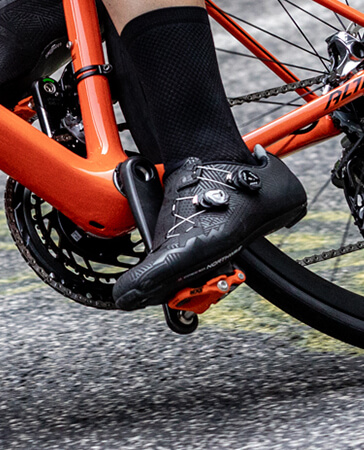
In addition to all the technical components of a racing bike, it is important to consider that there are also many very useful accessories that can be combined with it, with different choices according to needs, objectives and habits.
The most important racing bike accessories are:
- Pedals: there are still some amateur cyclists who do not like quick release pedals and use classic ones, with adapters for optimal shoe adherence. Quick-release pedals, however, are used by almost all cyclists of all levels and can be in titanium or carbon, which are more expensive but also lighter, or in aluminium, cheaper and slightly heavier.
- Shoes: of course, they must be combined with the pedals. Carbon shoes are more expensive, but also light and stable. Plastic ones are cheaper, but heavier.
- Saddle bag: it is a virtually essential accessory. Smaller ones are normally used to carry supplies in case of puncture: a spare inner tube, a pump, and levers to remove and replace the inner tube and tire. Larger ones can also fit technical clothing and food.
MAINTENANCE FOR YOUR RACING BIKE WHEELS
Racing bike wheels must be maintained with the utmost care, as their economic, technical, and mechanical value is very high. Much of the performance offered by the bike depends on the wheels, their quality, their state of wear and conservation; it is therefore essential to check the condition of the wheels at the end of each ride, and proceed with any maintenance needed.
There are fundamentally three important procedures to perform for the proper maintenance racing bike wheels:
- Washing the wheels after every ride
- Inflating the tires
- Cleaning and performing maintenance on each wheel component
Cleaning the wheels is essential to extend the life of the wheels. After each ride, even if you have not cycled on gravelly, muddy, or dusty roads, it is good practice to remove the wheel and clean it with a wet cloth and detergent, carefully wiping the rim, the spokes and also the tires. The wheel of a racing bike can also be washed with a water jet, provided that it is not too powerful, otherwise it can deteriorate the components of the bike.
In order to keep wheels in top condition, they must be correctly inflated, which is normally 7.5 atm for the front wheel and 8 for the rear. It is certainly harmful for the wheels to travel with tubes that are much too deflated.
Not necessarily after each ride (unless you have cycled on dusty or muddy roads) but very often nonetheless, it is advisable to check the bearings, the quick release and the sprocket set. If you are not confident in the cleaning and maintenance of these components, don’t hesitate to contact your trusted mechanic.
HOW TO CLEAN YOUR RACING BIKE
In order to work perfectly, a racing bike must be kept in excellent shape. Which means, first of all, it must be clean. Not because it should shine when you ride, but for a much more important reason: cleaning extends the life of every single component. If they are not maintained with the right care, many elements of the bike will rust, deteriorate, and decrease in performance, forcing you to replace the component.
So, after each ride, your racing bike must be thoroughly cleaned. Here is how to correctly clean a racing bike.
Certain procedures must be followed:
- Rinsing
- General cleaning
- Deep cleaning
- Rinsing
The first step is to rinse the entire bike, with a bucket of water or with a pressure washer, provided that the water jet is not too aggressive on the bike, which could ruin some components.
Then, with a cloth, remove surface dirt, dust and mud that have crept into the bike frame, clinging to the most delicate components. Wipe the cloth throughout the frame, the spokes, the chain, and every easily accessible point.
Then, it is important to check each individual component, and clean then thoroughly when needed (brakes, gearbox, chain).
When finished, rinse again, removing the last remaining dirt particles.
At this point, dry the bike with a dry cloth that will not damage the bike frame.
CLEANING ROAD WHEELS
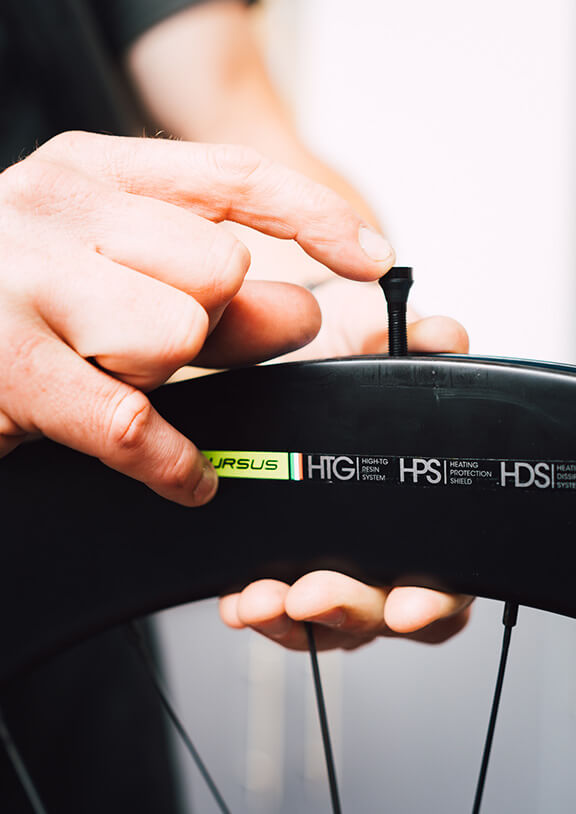
TOP RANGE RACING BIKE WHEELS: HERE ARE THE MIURA TC SERIES
The Miura TC series (composed by Miura TC37 and Miura TC67 in the versions V-brake and for disc brakes) is the state of the art when it comes to top-of-the-range racing bikes. These rims were designed to yield high performance in competitions, while ensuring a great comfort level during long outings. This is made possible by the wideness of the internal diameter (28 mm), allowing cyclists to mount clinchers or tubeless tires between 20 and 30 mm.
What does this mean?
- More safety: wider road bike tires are certainly more controllable on wet, rough, or muddy terrain. This has positive results, especially on the grip during curves. Additionally, if you have chosen disc brakes, their powerful braking will be distributed onto a larger surface in contact with the asphalt.
- More comfort: oversized tires can be kept more deflated. With less inflation pressure, holes and roughness of the ground are better absorbed. Better cushioning allows you to give your best, especially on long-distance tracks.
- More reliability: with tubeless or clincher tires, you have the possibility to rely on self-repairing tires or, in any case, you can replace them in a few minutes. Compared to tubulars, you will have to deal with a few more grams, but you will be sure that you will not have to abruptly suspend your ride due to a puncture.
MIURA TS37 AND TS47 DISC: THE TUBULAR TIRES CHOSEN BY THE TOTAL DIRECT ENERGIE TEAM
The Miura TS37 EVO and TS47 EVO in their disc brake version are a well-tested Ursus classic. In their team edition colours, these pairs of wheels shine on the Wilier Triestina Zero SLR of the Total Direct Energie Team. Why do racers love these products?
The tendency to alternate very high-profile wheels for fast racing sections and low-profile wheels for climbing sessions is a thing of the past. Today, it seems that pros need to be able to count on a medium-height wheel set that can offer maximum performance on mixed routes. From this point of view, Miura TS37 EVO Disc and Miura TS47 EVO Disc are the best choices.
These tubular wheels are made of high-quality carbon and connect the new Ursus RD40 center lock aluminium hubs. The rim profile heights are respectively 37 mm (on Miura TS37 EVO disc, for mixed routes with climbs) and 50 mm (on Miura TS47 EVO Disc, for mixed routes with fast sections). Both have an internal diameter of 24 mm.
What are the best Ursus racing bike wheels according to the pros?
Ultimately, this segment of the Ursus range is the most chosen by the cyclists of the Total Direct Energie Team because of its distinctly “racing” characteristics, which make it ideal for obtaining maximum performance in highly competitive events such as the Giro d'Italia, the Classics and the Tour de France .
RECOMMENDED PRODUCTS
WHEELS FOR THE NORTHERN CLASSICS? THE TOTAL DIRECT ENERGIE TEAM TEST
Pre-season is for us the ideal time to organize product tests in collaboration with professional runners. This year, we decided to test our 28 mm wheels on the official route of the Paris-Roubaix and the examiners were none other than the cyclists of the Total Direct Energie Team.
At the start, there were the wheels for tubulars Miura TR37 Disc and their counterpart for tubeless/clincher, the Miura TC37 Disc. During the testing phase, it emerged how the two models can offer different solutions to the French champions throughout the year: both ensure excellent stability and better curve grip than 24 mm diameter wheels. However, while the version for tubulars was more performing in terms of reduced weight and smoothness, the tubeless version ensured slightly better reliability and riding comfort.
Ultimately, when it came to choosing their wheels for the Paris-Roubaix, the riders were divided between those who decided to continue betting on tubulars and those who found it less risky to opt for tubeless, with a slight prevalence of the first case.
THE INTEGRATED RACING BIKE HANDLEBAR BY URSUS: MAGNUS H.01
It’s not all about wheels. You may not know that Ursus has distinguished itself for more than fifty years in the production of bicycle components. One of the most interesting components of our racing segment is undoubtedly the Magnus H01 integrated handlebar.
Made of carbon monocoque with specific reinforcements in the areas where the levers are positioned, this handlebar is the true essence of technology.
First of all, we are talking about a product that is suitable for every cyclist. Unlike other products of this segment on the market, Magnus H.01 offers you the possibility to choose between different sizes. You can do this without letting the adaptation of the shapes to the different sizes impact the aerodynamic structure of the handlebar. The brake cables are housed inside, and it makes it easy to mount a bike computer. Rigidity and resistance are at the top, as are the ergonomics that you can feel.
The position of your hands will always be 100% correct. This is possible thanks to the flattened profile, which allows for a more comfortable high grip. The shapes of our integrated handlebar are sinuous, designed to adapt to the lines of many bikes on the market.
This brings us to design, another strength of the product. Magnus H.01 stands out for its linear shape, an unmistakable Ursus style signature. Available in two different colours, in glossy or matte finish, this carbon racing bike handlebar will perfectly adapt to your bicycle.




